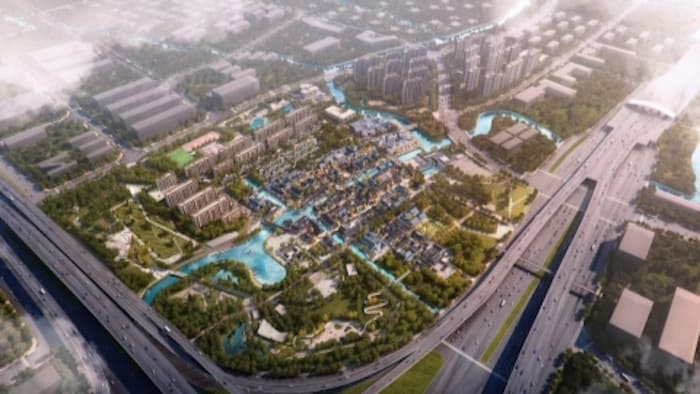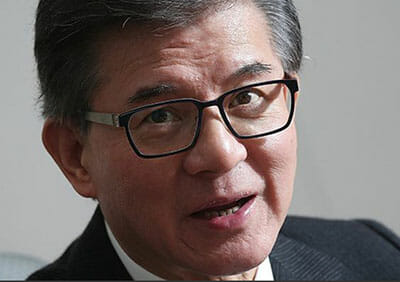
Shui On Land’s planned Panlong Tiandi development
Shui On Land spent RMB 2.1 billion ($290 million) buying four parcels of land in Shanghai in just three days last week, as the developer assembles the pieces for an urban redevelopment project which it hopes will rival the success of its landmark Xintiandi project in the city centre.
The Hong Kong-listed developer, which is led by billionaire property tycoon Vincent Lo, said on 21 May that it had won the land use rights for a pair of commercial plots that will form part of its Panlong Tiandi project in western Shanghai’s Hongqiao area at a land premium of RMB 429.6 million.
Just two days earlier, the firm had spent for RMB 1.7 billion to purchase a pair of residential sites as part of the same western Shanghai redevelopment.
The acquisitions follow Shui On Land’s RMB 3.9 billion purchase last November of a set of four residential land parcels, which together with this latest set of acquisitions, provide the footprint for the project near Shanghai’s Hongqiao transportation hub.
Aiming for a Xintiandi-Style Hit
With these purchases bringing to a close the developer’s planned land acquisitions for the residential and lifestyle development, Shui On Land said Panlong Tiandi will offer 250,000 square metres (2.7 million square feet) of homes in the style of its fashionable Xintiandi development in the city centre as well as a cultural and entertainment hub.

Shui On Land’s Vincent Lo is heading for Shanghai’s suburbs
“We are honoured to win the development right of the whole Panlong Tiandi project, an exceptional initiative in the Great Hongqiao area,” chairman Vincent Lo said in a statement, adding that the company had a “strong track record in urban renewal and cultural heritage, as well as in developing vibrant world-class master-planned communities”.
Located adjacent to the Panlong Road metro station in Qingpu district, Panlong Tiandi is one stop west of the National Exhibition and Convention Centre, and two stops from Hongqiao railway station and Hongqiao International Airport on metro line 17.
Assembling a Development Site
On 21 May Shui On purchased a commercial site comprised of a pair of parcels measuring a combined 56,938 square metres. The project includes approval for up to 48,659 square metres of finished real estate, including up to 44,350 square metres of cultural and recreational space, and a hotel and restaurant of a combined maximum of 4,309 square metres.
At the land premium of RMB 429.6 million, the developer paid RMB 8,829 per square metre for of gross floor area in the project.
That commercial purchase came after Shui On had bought up a pair of residential land parcels on 19 May, which combined create a a 33,618 square metre site. The developer agreed to pay a total of RMB 1.7 billion for the two plots, which combined will yield up to 74,018 square metres of new home.
At the agreed land premium paid, Shui On is paying the equivalent of RMB 22,967 per square metre for the two residential parcels, and the company said it expects to launch the first sales of units at the end of this year.
Revitalising a Shanghai Suburb
In developing Panlong Tiandi, Shui On says that it intends to re-use conservation buildings in a style similar to reconstructed Xikumen style which contributed to Xintiandi’s fame when that Huangpu district project opened in 2002.
Out in Qingpu, the developer now says that for its new project, it will repurpose part of a historic water town in the area, as it evolves the Xintiandi brand to create “a new social and cultural destination” in western Shanghai.
“Shui On has a strong track record of master planning and place-making in Shanghai with the commercial components of the development driving value and appeal for the residential component,” said Savills head of research in China, James Macdonald, adding that the developer’s strategy is to “create value through placemaking”.
Macdonald noted that high-end residential developments in the area currently sell for between RMB60,000 and RMB 70,000 per square metre.
Shui On, which opened its “The Hub” commercial project near Hongqiao airport in 2015, sees the opening of line 17 three years ago as connecting what were once far-flung sections of the city more closely with the urban core and helping to drive demand for housing in the district. Also known as ‘the Qingpu LIne’, the 35 kilometre light rail system runs west from the Hongqiao transport hub to the Oriental Land station near Dianshan Lake.
“Given limited land resources in city centre areas in particular in first-tier cities like Shanghai, we believe in urban regeneration, as it provides a sustainable option for livable cities,” said Stephanie Lo, Shui On Land’s executive director.
Lo added that the company is committed to continuous investment in China, despite slowing economic growth in the wake of the COVID-19 pandemic, and added that Shui On will continue to replenish its 8.8 million square metre land bank in the country, especially in the company’s core market of Shanghai.
Insurer JV Provides a Boost
Shui On Land has been ramping up its land acquisitions since joining forces with insurance giants China Life and Manulife Financial in a development joint venture at the start of 2019.
State-owned China Life Insurance contributed $100 million to the JV, while Canadian multinational Manulife Financial invested $450 million, and Shui On Land added $200 million of its own to the fund.
Prior to that tie-up, the developer had been struggling with a mounting debt pile which had forced it to raise funds by selling off assets including the 2017 sale of a 49 percent stake in the Shanghai KIC development to China Life for RMB 2.95 billion.
Leave a Reply